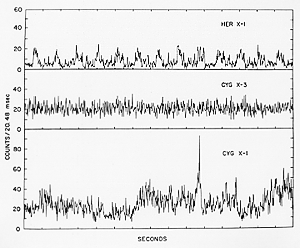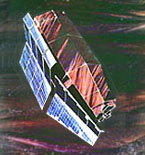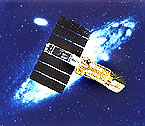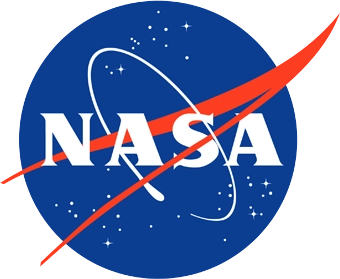A History of X-ray Astronomy at Goddard
A History of X-ray Astronomy at Goddard
Balloons
In 1965, at the suggestion of Frank McDonald, Elihu Boldt initiated Goddard's program in X-ray astronomy with a series of balloon-borne experiments. At an early stage he was joined by Peter Serlemitsos, who had just completed his PhD space physics thesis on magnetospheric electrons, and by Guenter Riegler, a University of Maryland physics graduate student interested in doing his dissertation research in astrophysics.From 1965 to 1972 there were over a dozen balloon-borne experiments (mostly from New Mexico), including the first such to take place from Australia (1966), one in which hard X-ray emission was discovered (albeit with crude angular resolution) from a region towards the galactic center whose centroid is located among subsequently identified sources GX1+4, GX3+1, and GX5-1. A balloon-borne experiment in 1968 was based on the multi-anode multi-layer xenon gas proportional chamber that had recently been developed in our lab and represented the first use of such a high performance instrument for X-ray astronomy.
Due to the attenuation of soft X-rays by the residual atmosphere at balloon altitudes these early experiments were restricted to energies above ~20 keV. Observations down to lower eneregies were begun with a series of high altitude sounding rocket experiments; by this stage Steve Holt had already joined the program. A 1972 rocket-borne observation of Cas A, the youngest supernova remnant in our galaxy, yielded the first detection of an X-ray spectral line, iron K-line emission at ~7 keV.
Rockets
 The figure at left shows 15-second samples of the raw counts (per 20.48ms)
observed in a 1973 sounding-rocket-borne exposure to three of the X-ray
brightest binary sources in our galaxy: Her X-1 (1.7 days), Cyg X-3 (0.2
day), and Cyg X-1 (5.6 days). The 1.24 second pulsar period associated
with Her X-1 is immediately evident from the data, while the rate profile
for Cyg X-3 is completely consistent with the statistical fluctuations in
counts expected for a source that is constant, at least for the 15s
duration of the exposure shown; the Cyg X-1 data, on the other hand,
clearly exhibit the chaotic "shot noise" behavior characteristic of this
black-hole candidate and also provided preliminary evidence for the
additional feature of millisecond "burst" sub-structure, noted for the
first time in this observation. The sharp cut-off at ~24 keV in the flat
spectrum observed for Her X-1 in this exposure provided the first reported
evidence for radiative transfer effects to be associated with a highly
magnetized plasma near the surface of a neutron star. The black-body
spectral component observed for Cyg X-3 during this experiment gave strong
evidence that this emission is from the immediate vicinity of a compact
object the size of a neutron star.
The figure at left shows 15-second samples of the raw counts (per 20.48ms)
observed in a 1973 sounding-rocket-borne exposure to three of the X-ray
brightest binary sources in our galaxy: Her X-1 (1.7 days), Cyg X-3 (0.2
day), and Cyg X-1 (5.6 days). The 1.24 second pulsar period associated
with Her X-1 is immediately evident from the data, while the rate profile
for Cyg X-3 is completely consistent with the statistical fluctuations in
counts expected for a source that is constant, at least for the 15s
duration of the exposure shown; the Cyg X-1 data, on the other hand,
clearly exhibit the chaotic "shot noise" behavior characteristic of this
black-hole candidate and also provided preliminary evidence for the
additional feature of millisecond "burst" sub-structure, noted for the
first time in this observation. The sharp cut-off at ~24 keV in the flat
spectrum observed for Her X-1 in this exposure provided the first reported
evidence for radiative transfer effects to be associated with a highly
magnetized plasma near the surface of a neutron star. The black-body
spectral component observed for Cyg X-3 during this experiment gave strong
evidence that this emission is from the immediate vicinity of a compact
object the size of a neutron star.
An observation of Cyg X-3 a year later with the same instrument yielded an optically thin thermal spectrum for this source and provided the first evidence for strong spectral iron K-line emission from an X-ray binary.
Orbiting Observatories
 Our large area PCA (Proportional Counter Array) on the current RXTE (Rossi X-ray
Timing Explorer) mission genuinely reflects
the heritage of our sounding rocket program. RXTE continues to provide
very valuable data as it enters the second decade of successful
operation.
Our large area PCA (Proportional Counter Array) on the current RXTE (Rossi X-ray
Timing Explorer) mission genuinely reflects
the heritage of our sounding rocket program. RXTE continues to provide
very valuable data as it enters the second decade of successful
operation.
Goddard's ASM (All-Sky Monitor) pin-hole X-ray camera on Ariel-5 (1974-1980) was the first X-ray astronomy experiment to use imaging proportional counters (albeit one-dimensional); it provided information on transient sources and the long-term behavior of several bright objects. Jean Swank joined the program in time for the beginning of our OSO-8 experiment (1975-1978), the first broadband (2-40 keV) orbiting observatory based on multi-anode multi-layer proportional chambers, one that showed the power of X-ray spectroscopy; for example, it established that iron K-line emission is a ubiquitous feature of clusters of galaxies.
The
HEAO-1 A2 full-sky cosmic X-ray experiment (1977-1979) provided the
most comprehensive data (still the most definitive) on the cosmic X-ray
background broadband spectrum and large-scale structure, and a much used
complete sample of the brightest extragalactic sources;
 it posed the challenging "spectral paradox" just now being unraveled with
new results on evolution (from deep surveys) and on individual source
spectra extending into the gamma-ray band. The SSS (Solid State
Spectrometer) at the focus of the HEAO-2
Einstein Observatory (1978-1981) grazing incidence telescope was the
first high spectral resolution non-dispersive spectrometer to be used for
X-ray astronomy, here for energies up to ~3 kev, limited by the telescope
optics.
it posed the challenging "spectral paradox" just now being unraveled with
new results on evolution (from deep surveys) and on individual source
spectra extending into the gamma-ray band. The SSS (Solid State
Spectrometer) at the focus of the HEAO-2
Einstein Observatory (1978-1981) grazing incidence telescope was the
first high spectral resolution non-dispersive spectrometer to be used for
X-ray astronomy, here for energies up to ~3 kev, limited by the telescope
optics.
By the use of conical foil optics, developed in our lab, the response of a
grazing incidence X-ray telescope was extended to 12 keV, amply covering
the crucial iron K-band of emission. A cooled Si(Li) solid state detector
was used at the focus of such a telescope for the BBXRT
(Broad Band X-Ray Telescope) on the Astro-1 shuttle mission (STS-35)
 on Columbia in December 1990, the first broadband (0.3-12keV) X-ray
observatory to use focusing optics. In collaboration with X-ray
astronomers in Japan, Goddard supplied conical foil X-ray optics have been
used for the joint Japanese/American ASCA mission
(1993-2000), the first broadband imaging observatory using CCD non-dispersive
spectrometers.
on Columbia in December 1990, the first broadband (0.3-12keV) X-ray
observatory to use focusing optics. In collaboration with X-ray
astronomers in Japan, Goddard supplied conical foil X-ray optics have been
used for the joint Japanese/American ASCA mission
(1993-2000), the first broadband imaging observatory using CCD non-dispersive
spectrometers.
Substantial improvement in the capability of solid-state non-dispersive spectrometers has been achieved in our lab (in collaboration with the University of Wisconsin) by the successful development of quantum calorimeters with resolution better than 10 eV (FWHM). Such spectrometers have been used in a sounding-rocket-borne experiment to study spectral lines from the hot interstellar medium of our galaxy and will soon play a major role in the joint Japanese/American Suzaku orbiting X-ray observatory launched in July 2005.
The critical early stages of this program benefited from highly dedicated technical support by Dale Arbogast, Frank Birsa, Ciro Cancro, Upendra Desai, Henry Doong, Charles Glasser, Sid Jones, and Frank Shaffer. More than 20 graduate students (mostly from the University of Maryland at College Park) have successfully carried out their PhD dissertation research within our X-ray astronomy program. Almost all of these former students have remained actively involved with astrophysics.
